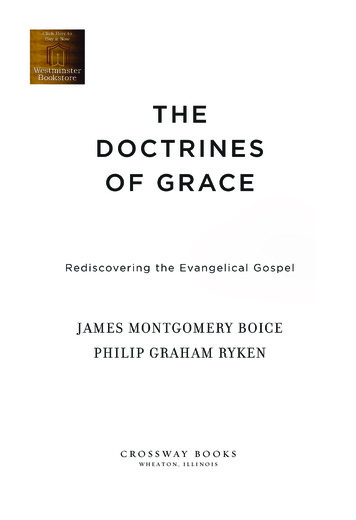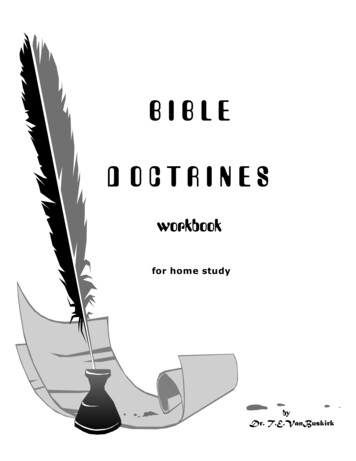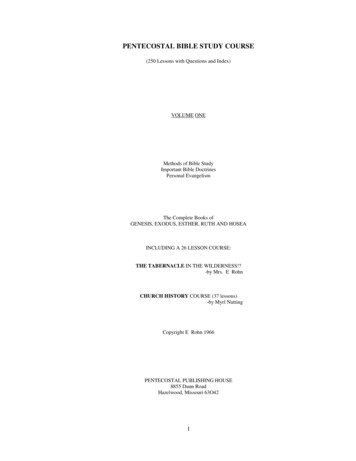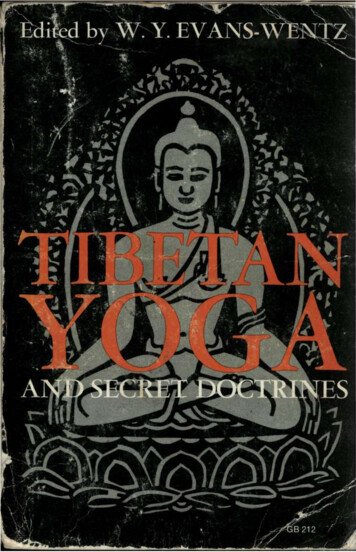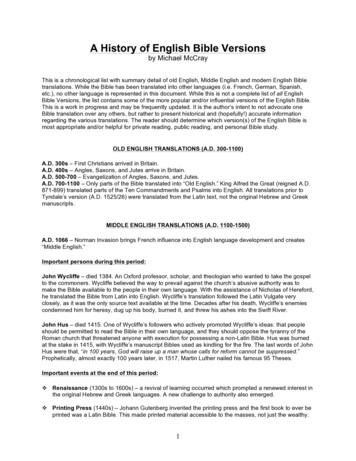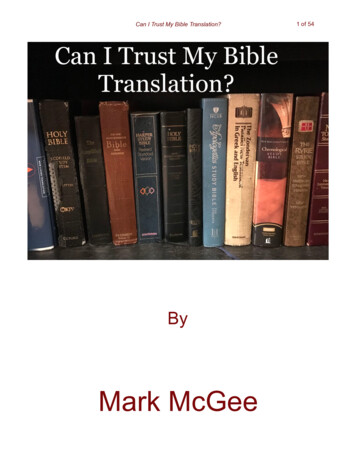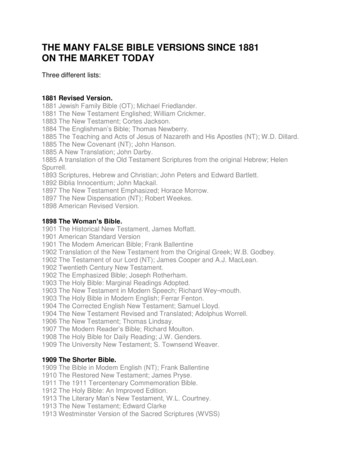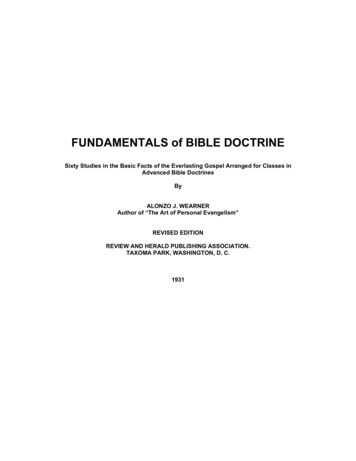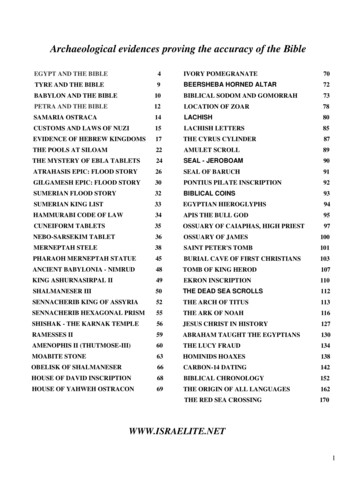
Transcription
BIBLEDOCTRINESBIBLE CENTERED STUDIESTEACHER’S HANDBOOKErnest A. Clevenger, Jr.
BIBLE DOCTRINESFirst Edition published by Christian Quality Supply, Birmingham, AL, as one ofthe Bible Centered Studies series, written by Ernest A. Clevenger, Jr. andSamuel G. Hill, and Copyright, 1967, by Christian Quality Supply. This editionedited, revised, and enlarged, 2011, by Ernest A. Clevenger, Jr. Copyright, 2011 by Ernest A. Clevenger, Jr.Published by Clevenger Publications1136 Lipscomb DriveNashville, TN 37204Email: clevengerea@comcast.netPermission is hereby given to freely reproduce, use, and/or print thisbook without additions or deletions or changes of any kind.2
FOREWORDThe eleven books in the Bible Centered Studies Series were originallywritten over a period of fourteen years, from 1960 to 1974: a time when rote wasan acceptable, enjoyable and profitable method of teaching and learning. Eachof the editions consisted of a Teacher's Handbook and the associated StudentGuide containing a special instructional method utilizing rote. Each book hadfrom 60 to 100 Key words or terms related to the Bible subject. The teachingmethod used in the series is not solely rote, although that word helps to describethe methodology.The eleven books in the Bible Centered Studies Series are:The Bible, 1960: an history of the English Bible and annotatedoutline ofits contents.The History of God People, 1963Bible Geography, 1965Jesus of the Bible, 1965Wisdom Books of the Bible, 1966Bible Doctrine, 1967Bible Evidences, 1968Bible Survey, 1969Bible Characters, 1970History of the Bible Church, 1971The Godhead and the Bible, 1974Originally produced for Central Alabama Christian Youth Camp (CACYCamp), Birmingham, AL, the series became popular worldwide for use inChristian Youth Camps, in Vacation Bible Schools, Sunday Schools, and in othertypes of Bible class work. Although emphasis is upon camp use, the adaptabilityfor use in other areas was always readily evident. This series came about as theresult of using a novel teaching method which was proven enjoyable, profitableand challenging, especially to young people ages seven through seventeen andparticularly in a Christian Youth Camp environment.By trial and error, over a period of eight years, Bible Centered Studiesmethod was refined to an art. This method is no experiment. We discoveredcampers studying by flashlight under their blankets after lights out, standing inmeal line studying, using free time and other time to get one more chance to goover their Bible class drill work, causing us to become a devotee of the BibleCentered Studies method.THE HANDBOOKThe handbook contains all the material essential to presenting meaningfullessons that are vital to Christian young people. With the Bible as a textbook, thishandbook, through the teacher, will direct students in a study of great importancein leading one to Christ or giving a .better understanding of how a Christianshould live. The success a teacher has will not depend upon this handbook;rather it will depend upon the textbook, the Bible, and upon the teacher’spreparation to present the lessons in an effective manner.3
THE STUDENT GUIDEWith the Bible Centered Studies method it is not necessary for studentsto have an elaborate workbook or a copy of the handbook. They will need theirBibles. They will not need to write anything, nor make any advanced preparationfor each new lesson; another reason why the method is ideal for camp, VacationBible School, and Sunday School use. The student’s guide contains only the keyterms, definitions and outlines, all in consecutive order. The study is designedfor the class to cover the material as fast or as slowly as the teacher wishes. Afree PDF of the Student Guide, as well as the Teacher Handbook PDF, may befound and downloaded at http://www.clevengers.info/Clevenger ErnestJr/ernest allen clevenger.htm.THE METHODThe experienced teacher may use whatever methods he/she wishes. Themethod recommended for use with Bible Centered Studies is based upon theinherent advantages of drill work. The method is not solely rote: the method isthe introduction of Bible facts by the teacher to the student with sufficientassociation and related material to enable the student to retain and use thesefacts by learning certain key terms. These key terms, in turn, trigger the memoryto produce a definition which further causes recall of the desired lesson orlessons. The outlines in the lesson are about Biblical groups of geographic orhistorical places or events used in relation to some of the key terms.This method permits students to have ready for use vast amounts ofmaterial, but initially responsible for relatively few key terms and definitions. Theteacher, using the Bible and handbook, introduces a key term and discusses it.Then, he/she introduces its’ definition and discusses it. One or more studentsmight be called upon to explain each term in their own words to ascertain if theteacher got the message across.Then a second key term is introduced,discussed, etc. Emphasis is placed upon the key terms, the definitions and theoutlines and the meaning of each.The teacher should be able to ask a student, anytime following thepresentation, any key term by giving the definition, or the definition by giving thekey term. As an example: should a key term be “Mount Moriah,’’ the studentwould respond with the definition “Abraham offered Isaac”, or, vice-versa. Ifcalled upon further, the student should be able to explain how God commandedAbraham to offer Isaac as a sacrifice, how they journeyed to Mount Moriah, todaythe city of Jerusalem, prepared the sacrificial altar, laid Isaac on it, and an angelof the Lord stopped Abraham who then found a ram which was offered.Abraham’s obedience was a test of his faithfulness. All of this information aboutthe Bible story would be based upon the presentation previously made by theteacher.Some of the material needing to be studied cannot be reduced to a keyterm and brief definition. In such cases, an outline is used. As a rule, the teacher4
will spend less time presenting outlines than key terms because the outlines aremore self-explanatory. These outlines are brief and arranged for rapid retention.Frequently, outlines are associated in part with one or more key terms anddefinitions.After presentation of the key terms and outlines, to indelibly impress themupon the student’s mind, a drill period is held. It may be conducted in one ormore of the following ways, or by a combination of them.(1) The teacher calls out the key term and the class responds inunison with the definition.(2) The teacher gives a key term and calls on a student to give thedefinition.(3) Divide the class into small groups. Students take turns callingout the key terms, others in the group either individually or in unisonreply with the definition.(4) Number the class consecutively. Pair off students by one oddand one even number. Have students drill one another by onegiving the key term and the other replying with the definition.(5) Conduct the drill session like a spelling bee; those who miss areeliminated and sit down.(6) Conduct the drill session by having students stand in a straightline. Those who answer correctly move to the head of the line,those who miss to the foot. Object: Try to stay near the head of theline.(7) Have students stand in a straight line. Set a time limit (5seconds). Students who miss must go to foot of line. Object: To tryto work yourself to the head of the line by not missing.Many of these suggestions may be used by first giving the key term andexpecting the definition, then reversing the process by giving the definition andexpecting the key term. Once students learn the method it never ceases to be alearning situation which is fun.CLASS PROCEDUREBible Centered Studies series themes are adoptable for many types ofcamp and Bible class situations. Following are two suggestions as to a BibleCamp procedure: one for a week’s camp, the other for a two week camp.Variations such as two class periods per day can be easily managed. Themesfrom the series have been successfully used in adult classes, Ladies Bibleclasses, and Teen and College classes over periods as long as one year by theteacher expanding the handbook material with visual aids and information5
obtained from other sources.For the most effective camp use, campers should be divided into classesof from 15 to 20 students each, no more than 25. These classes should beformed by age or pier groups. The methodology works best when students of thesame age study together.For A One Week Camp or VBSSuggested class schedule for a one hour class.Check roll and open class with a prayer5 minutesPresent new material25 minutesDay One: Drill on new material30 minutesDay Two and following: Review Drill of old material 15 minutesDay Two and following: Drill on new material15 minutesAfter the introduction of the subject at the first class period, beginpresenting key terms and definitions. Early in the week more time will need to bespent presenting material than in drill; toward the end of the week more timeshould be spent in drill than in presenting new material. Thus teachers shouldplan their lessons to cover a great number of key terms in early classes.Percentage wise, for a one week, one lesson a day class, the presentation of keyterms and outlines would be as follows: 1st day, 30%; 2nd 25%; 3rd 20%; 4th15% and 5th 10%.For a one week, two daily class periods camp, the percentage of keyterms and outlines to be used would be as follows: 1st class, 20%; 2nd class,15%; 3rd through 8th classes, 10% each; and 9th class, 5%. The 10th classwould be used for testing. The more classes, and the longer the class, the moretime for both presentation and drilling.For a Two Week Camp or VBSThe same basic schedule as for a one week camp is used. Should oneclass per day be held, Monday through Friday, the same percentage of key termsand outlines to be presented daily as for a one week camp, two daily classeswould hold true. For a two class per day, two week camp the followingpercentages should be observed. 1st class, 10%; 2nd through 19th classes, 5%;and the 20th class used for testing. At longer camps, and for some themes, someclass time may be devoted to projects and visual aids which are related to theBible study theme.INCENTIVES FOR LEARNING“There is no royal road to learning.” Some things, such as themultiplication tables, have to be learned by rote. In the Bible Centered Studiesseries, memory work is of prime importance. Some things have to be learned bydrilling over and over; which really is an excellent manner of retention andlearning. To aid in learning the material to be covered, the author has madeevery conscious effort to relate important names, places and events both in alogical sequence and by a direct appeal to the Word of God.6
In addition to these efforts, two other suggestions are offered as incentivesfor learning. These may be used either on a camp wide or total VBS basis or forindividual classes.To encourage learning, it may be desirable, challenging and fun, to havewhat might be called a “contest”, or an “elimination” to determine which studentshave retained the greatest amount of material. The elimination is based uponability to retain key terms, definitions and outlines, and not upon the knowledgeabout these. The knowledge must be imparted, if possible, during the course bythe teacher and the memorizing of these terms is to serve as an aid in retainingthe knowledge.One successful method of eliminating all but the students who havelearned well these terms is similar to a spelling bee and is as follows: Thestudents are placed in a straight line, the teacher designates one end of the lineas the “head” and the other end of the line is designated the “foot.” Beginningwith the head of the line, the first student is given a key term, such as “Eden”.The student should answer “Adam and Eve”. Should the student answercorrectly, he/she remains at the head of the line and the next key term is given tothe next student. Should he/she miss, or be unable to give the correct answer,he/she goes to the foot of the line. The one remaining at the head of the line atthe end of the time designated (20-30 minutes) is the winner.Have A Double EliminationTo have a double elimination, that is to allow more than one chance toanswer correctly, the procedure is as follows: Assemble the students as for aspelling bee. When a student fails to answer correctly, let them form a secondline. See the drawing. When a student in line one, A, misses or fails to answerhe/she moves to the foot of line two. Then, B, the first student in line two is givenan opportunity to answer correctly; if he/she cannot he/she goes to the foot of hisline, C. Should he/she answer correctly, he/she goes to the foot of line one, D, tobegin his second chance for one of the top places or the top place in his class.Each person in line two should be given the opportunity to answercorrectly until someone does, or it is evident that none in the line know theanswer. The questioning then returns to the head of line one and continues theprocess. In some contests any student who misses twice is eliminated then.Some camps have gold ribbons printed to offer as rewards to winners of theelimination contest. Others give nice Bibles to winners. It is possible for morethan one student to have memorized all the correct answers, backward andforward. This is the purpose of the class drill and of the contest to encourage justthat. In such cases, more than one “winner” will have to be announced for the7
class.Often, in a group, after the individual classes have conductedeliminations, the entire school or camp will have a contest to determine the groupwinners. All students should remain with their class, or group, as hearingrepeatedly the terms and definitions and recitation of the outlines will onlyenhance their retention.One camp awards 1st place gold ribbons to all who are left standing in theelimination contest at the end of a thirty minute period. Runner-up gold ribbonsare presented to the remainder of the contestants. Contestants for the campcontest are chosen from the classes by class elimination. It is not unusual forone-third or more of the campers to receive a BIBLE ACHIEVEMENT goldribbon.8
SPECIAL NOTE TO TEACHERSVarious helps have been included in the Handbook to assist you inteaching Bible Doctrines. Being aware of these helps will make the Handbook ofmore value to you.Several Internet resources are available with articles, lectures anddiagrams which can supplement the martial in this book. Some are:Apologetics Press. A section on “Doctrinal Matters” contains manyarticles addressing the doctrinal subjects covered, and other themes found in thisbook. www.apologeticspress.org/APContent.aspx?category 11.Does God Exist? The site contains downloadable material, charts, andarticles.www.doesgodexist.org/.Christian Courier. The Christian Courier is a journal dedicated to thestudy of religious doctrine, Christian evidences, and biblical ethics associatedwith the churches of Christ. Most of the article are written by Wayne Jacksonand are downloadable. www.christiancourier.com/.Resource Material. Downloadable resource material by the author.www.clevengers.info/downloads.htm.Spiritual Sword. The Spiritual Sword quarterly journal, which began inOctober of 1969, has been edited by Alan E. Highers since 1989 and brings intoprint some of the finest literary efforts of noted men in the church today.Quarterly .Gospel Advocate Company. Book: Handbook on Church Doctrines,Stafford North. This handbook explores several topics as taught by ten differentchurches. Topics include: the nature of God, the nature of man, the scriptures,salvation, the church, worship and last things. This updated version also includesa new section on mpany/StoreFront.bokThe Outlines (A through H) in this study have been placed in as effective aposition as possible while at the same time being logically distributed throughoutthe Key Terms and Definitions. There are more outlines earlier in the study thantoward the end, the purpose for which is obvious when you understand thesystem to be used in presenting the material. More time is needed toward theend of the study for drill work, thus there is less time for presentation of newmaterial such as outlines.The word “doctrine” comes from the Greek, δόγμα, and the Latin, doctrina,meaning a codification of beliefs, or a body of teaching and is so used in thisHandbook.9
BIBLE DOCTRINESBIBLE CENTERED STUDIESTEACHER’S HANDBOOKBy Ernest A. Clevenger, Jr.1. ALL SCRIPTURE - Inspired of God.The English word inspired or inspiration has come down to us through avery unusual course. Primarily it comes from the Latin word inspiro which meansto “breath in”―hence our thought “to breath into the word.” Other common wordsin this area are pneumonia and pneumatic; as pneumatic tires (tires with air.)What is meant by “inspiration of God” in scripture? Much like “God”, it is notexplained but just stated as a fact. The wrong attitude toward what God does, inrelation to scriptural inspiration, is probably one of greatest problems. It is bestnot to think of God breathing “into scripture” but “through the scripture.”Inspiration is more the “how” of revelation (see Term 2); God, working on, in, andthrough the prophets, apostles, and writers, enabled them to receive and record,in a trust worthy manner, the revelation for man.The word inspiration, or inspire, is used only twice in most Englishtranslations but the idea is expressed throughout scripture by many differentwords and thoughts: Hebrews 1:1, “God spoke”; Exodus. 3:15, “God said”; IIKings 23:16, “proclaimed”; Isaiah 1:10, “hear the word of Jehovah”; Ezra. 7:1,“the word of the Lord came to me.” Both directly and indirectly, the OldTestament has over 4,000 claims to divine authority. In the New Testament it iswell summed up in Matthew 10:19-20, “When they bring you to trial, do not worryabout what you are going to say or how you will say it; when the time comes, youwill be given what you will say. For the words you speak will not be yours; theywill come from the Spirit of your Father speaking in you.” TEV.Two N. T. passages, giving most of the inspirational ideas,are:(1) II Timothy 3:16-17, “All scripture is inspired byGod.” Literally it is “God breathed” - a term used only here in all theN. T. Verse 15 calls them holy or sacred writings in that they are“set apart” by God working through them. As God breathes throughthese writings to us he gives us everything that we need in teachingfor reproof, correction and instruction in righteousness. In this,10
Paul is giving for Timothy’s direction a brief description of the resultof inspiration.(2) II Peter 1:19-21 gives almost everything we knowabout how God goes about the process of inspiration. In II Pet.1:12, Peter admonished them to be established in the truth; nowprophetic word is mode more sure as a lamp shining in a darkplace. Verse 20 tells that no prophesy of scripture is of one’s ownindividual interpretation. Verse 21: “for no prophesy (of scripture)came by the will of man but men spoke FROM God, being movedby the Holy Spirit.”Literally the minds of the prophets were picked up andcarried along by the power of the spirit working in them. Whathappened in the minds of the prophets we are not told―onlyassured that the words they recorded can be taken as the infallibleword of God who spoke through them.2. REVELATION - Uncovering.The words “revelation” and “inspiration” both come to us through the LatinBible. The Douay Version, translated from the Latin Bible, uses the Greek word“Apocaplypse” as the title for the last Book in the Bible; most English translationsuse the Latin word “Revelation”, which means to “uncover” or “unveil”. Inscripture, this is the uncovering of the mind of God to the mind of man. In timespast, God used different ways to uncover his will to mankind, Hebrews 1:1.Complete revelation came in Jesus Christ: “If you have seen me you have seenthe Father,” John 14:9. Revelation has been a gradual thing like the pulling backof a curtain; as man became spiritually capable of knowing more about God,more was revealed to him.Many things are known to us today which were hidden from great men ofthe past like Noah, Abraham, Moses and David. Also, there are a number ofthings that God has reserved to himself. The secret things belong to the Lord butthe revealed things belong to us, Deuteronomy 29:29. Our concern should beconcentrated on the revealed things. As under inspiration, the holy men of oldhad things uncovered to their minds by the Spirit. This is the way that Godrevealed the interpretation of Nebuchadnezzar’s dream to Daniel, (2:19). Again,as shown in Romans 1:20, God uncovers a part of himself in nature; sincecreation his invisible nature and power has been revealed in the things that aremade. The Heavens declare the glory of God and the firmament shows hishandiwork, Psalms 19:1.Important to man today are the specifics of revelation. The Gospel is thepower of God to salvation and in it the righteousness of God is revealed throughfaith, Romans 1:16-17. In I Corinthians 2:6-13 Paul takes up most of theimportant problems that one now faces. The hidden things of God cannot befound by the wisdom of this world. Part of the process was written by theprophets, Isaiah 64:4; 65:17. “The eye has not seen or ear heard nor heart ofman conceived the things God has prepared for those that love him.” God,through the Spirit, has revealed some of these things to Christians. Having thespirit that comes from God, one is able to understand things of the spirit of God―interpreting spiritual truths are for those who possess the Spirit. The non11
spiritually minded man is not able to receive these things for they are folly to him,I Corinthians 2:14-15.3. GOD - Creator.Growing side by side with our great advance of knowledge has been amarked growth in the advocates of the various “theories of evolution.” Most ofthese spring from the organic evolutionary theory and are in contradiction to themiraculous in creation as set forth in the Bible. The scriptures do not try to defendbut just state as a fact what happened ‘‘in the beginning” to bring this materialuniverse into existence.Chart 1Genesis 1:1 and John 1:1 simply states, “In the beginning God.” Therecord does not try to take us back before that time but gives this as an anchorpoint. The question may then be asked, “Who is God?” The Hebrew word isplural in form and is further explained in Gen. 1:26 when God said, “Let US makeman in OUR image.” This is the reflection of the trinity that came to light in theNew Testament. In the 0ld Testament the emphasis is on the unity of thegodhead. Isaiah 40:28 expresses His creative power, “you have not known, youhave not heard? that the everlasting God, the Lord, the CREATOR of the ends ofthe earth .“In the N. T. one finds that Jesus Christ was present and had a definite partin creation; as the WORD he was in the beginning with God and nothing wasmade without him, John 1:1-3. Paul further writes about Jesus, “the image of thein visible God, the first born of all creation, for in him were all things created in12
heaven and earth.” Colossians 1:15-16. The Holy Spirit had part and waspresent at creation; when the earth was void and without form the SPIRIT of Godmoved on the face of the deep, Genesis 1:2. The young man Elihu said, “thespirit of God has made me.” Job 33:4.The relationship between God, Jesus and the Holy Spirit, (sometimescalled the “Trinity”) and the separate entities, is shown in Chart 1 above. Thescripture passages confirm the person of God, or Jesus and of the Holy Spirit,and the chart shows their relationship and individuality.In order for there to be a “creation’’ in the Biblical sense it is a matter ofbringing something out of nothing; this means material that had not been herebefore - not just a matter of the rearranging of what already existed. Take forexample the creation of man, the crown of God’s creative activity: “In the imageof God created he him, male and female created he them,” Genesis 1:27. TheGenesis 2 account of creation of woman would take away anything but themiraculous hand of God. Man was created fully grown but incomplete in that hewas alone. It was then that God took a rib from Adam and created woman―fullygrown―as a helpmeet (helper suitable). God could have created woman as hedid man but he did not desire to do so. The great miracle of God’s creativepower is all about us.4. THE EARTH - Is the Lord’s (and the fullness thereof) Psalms 24:1.This term must be associated with theinformation given in the definition of Term 3where God is set forth as creator; since God isthe creator, the earth and all that is in itbelongs to him. It is so easy to forget that Godhas only entrusted these things to man for hisuse―not for him to possess or abuse.In Psalms 24, David, the man of God,acknowledges his relation to God the creator.Recognizing the divine ownership, he is awarethat the earth, in the sense of the materialthings about him, belongs to God; he is only asteward to care and use them to glorify God.David was a man of the outdoors, especiallyduring his youth; no doubt he had manyopportunities to experience God’s power in nature. He was close to God andsaw man as the height of God’s creative work; he seemed to be able to seethings in their proper perspective―the relation between man and the remainderof creation. His understanding of the working of God who made him a man afterGod’s own heart, Acts 13:22.The key is that the earth, in its fullness, belongs to God. Man canpurchase a small portion of the surface of the earth, or even the mineral rightsunder the surface, but this portion still belongs to God. The parable about the richfool, told by Jesus in Luke 12:13-21, so vividly brings out this lesson. This man,who had a bountiful harvest from the things of the earth, forgot that they were juston loan. When he was ready for his soul to take its ease―ready to eat, drink andbe merry―God asked for his soul and posed this question, “who would nowreceive all his possessions?’’ The wealthiest owner is but a tenant, who may at13
any moment, receive notice to quit. Let us never forget that the earth, and all itsinhabitants, belongs to God. He made everything and remains the sole ownerand master.5. FALL - Sin Enters the World.When man was created he was placed in the beauty and security of theGarden of Eden, Genesis 2:8. This was not to be a place of idleness for Adamwas told to dress and keep the garden. He was given complete freedom withone exception―he was not to eat of the tree of the knowledge of good and evilGod had planted in the midst of the garden, Genesis 2:16-17. At first man wasalone until God, realizing his need, made woman as a helper suitable for him.The scriptures do not reveal how long they lived in this state of paradise. Onething to note however is: mankind was endowed with reasoning and will powerthat was reflected in the process of the faIl.The only prohibition given to man was that in the day he ate of the tree inthe midst of the garden he would die. This restriction was accepted by man untilthe Serpent came into man’s world and challenged him to use his ability. He firstcame to Eve and asked if God had said she was not to eat of every tree of thegarden, Genesis 3:1. This was to put the woman on the defensive, but shequickly responded telling him they could eat of any fruit of the garden except theone in the midst of the garden; they were not to eat, or even touch it, lest theydie. (The “or even touch’’ was not in God’s command.) The serpent told her,“you shall NOT surely die,” and then assured them they would be as “gods,knowing good and evil”.With this enticement the woman apparently immediately went to theforbidden tree. She saw that it was good for food, delightful to the eye and itwas to be desired to make one wise. In the N. T. this is summed up in, “For allthat is in the world, the lust of the flesh, the lust of the eyes, and the pride of life,is not of the Father, but is of the world,” I John. 2:16. Every basic appeal wasused against the woman who was deceived and transgressed, I Timothy 2:14.When she sinned, she gave to her husband and he did eat. This process is stillwith us, seldom can one sin without effecting others in a very vital way.By this act, Adam let sin into the world, Romans 5:12. Not that we inheritsin from Adam, but men are now born into a world where sin is present. Sinceall men sin, all are subject to the results―that is death. It is not because ofkinship to the first couple, but man’s own willful act in sinning, Ezekiel 18:1-2.As one man, Adam, opened the door for the marring of the image of Godin man, so by one man, Jesus Christ, can this perfect image be restored,Romans 5:14-18. One is not automatically in sin through Adam, or automaticallysaved in Christ, except by one’s own personal act of following the one, JesusChrist, accepted as his Master.6. FLOOD- Evil Destroyed.From the time of the fall, and man being driven from the garden, until thetime of the flood, was about 1,500 years. This covered ten generations and manystartling events. Two outstanding events are recorded from this period:14
(1) Cain killed his brother, Abel, becoming the first murderer,Genesis 4:8-16.(2) Enoch, a righteous man, walked with God and was not, for Godtook him, Gen. 5:21-24.A general description of the situation just before the flood, when the sonsof God were marrying the daughters of men is given in the words, “thewickedness of man was great and the thoughts of his heart were evil continually”,Genesis 6:1-8. Noah was a preacher of righteousness but his preaching hadlittle effect
The eleven books in the Bible Centered Studies Series are: The Bible, 1960: an history of the English Bible and annotated outline of its contents. The History of God People, 1963 Bible Geography, 1965 Jesus of the Bible, 1965 Wisdom Books of the Bible, 1966 Bible Doctrine, 1967 Bible Evidences, 1968 Bible
